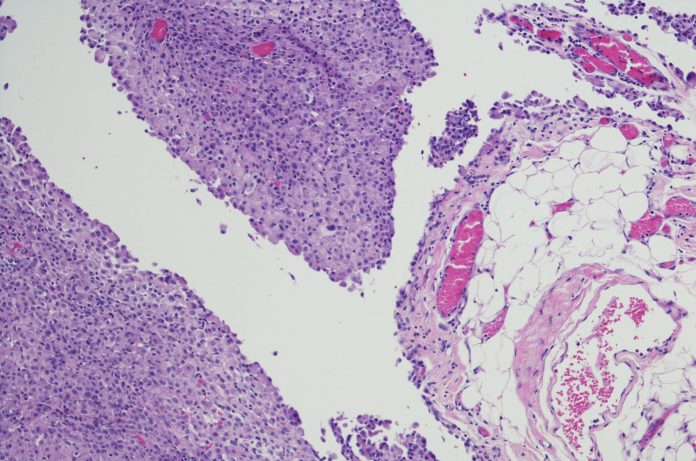Decades after the ban on asbestos, we still struggle with the impact of mesothelioma – is it possible to eliminate this devastating cancer? We put the question to UK charity Asthma + Lung UK
Despite the ban on asbestos in 1999, mesothelioma – a type of cancer caused by asbestos exposure – still claims the lives of more than 2,000 people each year in the UK. Concerningly, the UK has the highest death rate from mesothelioma in the world. (1)
This disease, historically linked to asbestos exposure, presents significant challenges in early detection and effective treatment, remaining a highly devastating occupational hazard. Despite advancements in public policy, occupational medicine and research, the prospect of a mesothelioma-free future remains unclear.
While intact asbestos isn’t harmful, the danger arises when it is disturbed, when microscopic fibres are released into the air. If these fibres are breathed in, they can get inside the lungs and cause irritation. Over time, this can cause damage the DNA, which can eventually cause mesothelioma to develop. The cancer begins to grow in the inner lining of the chest or the outer lining of the lungs, heart or stomach. The cancer cells multiply and begin to form small tumours. These tumours then spread and make it difficult to breathe. (2)
Men over the age of 60 who have worked in jobs where they were exposed to asbestos, such as construction, plumbing and some manufacturing, face the highest risk. (3)
Late diagnosis of mesothelioma also means that outcomes for people with the disease are often very poor. For example, in England, 45% of people survive their mesothelioma for one year or more after diagnosis, and only 5% survive for five years or more after diagnosis. (4)
Spotting mesothelioma: What to look out for
The elusive nature of early symptoms and the challenge of distinguishing mesothelioma from other respiratory conditions contribute to delayed diagnosis. This delay, in turn, limits treatment options for people affected by the disease. As the progression of mesothelioma unfolds gradually, especially in its early stages, there are often few noticeable signs. This subtle development further complicates the timely identification of the disease, demonstrating the importance of heightened awareness and early intervention strategies.
However, as the cancer advances, more symptoms emerge, including a persistent cough, fatigue, shortness of breath, chest pain, unintended weight loss, loss of appetite, increased sweating, difficulty swallowing, and a hoarse voice. Additionally, some people may experience changes in the shape of their fingers, known as finger clubbing, which is characterised by curvature or enlargement at the ends.
A distinctive feature of mesothelioma’s development is the accumulation of fluid in the lungs, referred to as a pleural effusion. This buildup stops the full expansion of the lungs during breathing, leading to a sensation of breathlessness. The insidious nature of these symptoms demonstrates the challenges in early diagnosis, often resulting in delayed medical intervention. As mesothelioma progresses, the display of these symptoms becomes more pronounced, emphasising the crucial importance of regular health check-ups and awareness campaigns to promote early detection and intervention.
Can we eradicate this devastating cancer?
A future without mesothelioma remains an ongoing challenge. In fact, mesothelioma currently has the worst five-year survival rate of the 27 most common cancers, including breast and prostate cancer. (5)
Although no longer in use, asbestos can still be found in roughly 300,000 non-domestic buildings, such as schools, hospitals and community centres, and almost one million domestic buildings. (6) Moreover, asbestos- related diseases are still the number one workplace killer in Great Britain. (7)
Between asbestos exposure and the development of the disease, there is a prolonged period of inactivity, which can last 30 to 40 years. This poses a substantial challenge in determining if someone is likely to develop the condition and highlights the long-lasting impact of historic asbestos use.
Asbestos-driven lung conditions, particularly mesothelioma, continue to impact the lives of thousands in the UK. Prevention is key, requiring robust workplace measures and targeted awareness campaigns. Collective action is vital to mitigate the impact of this silent killer, ensuring the safeguarding of future generations from the devastating consequences of asbestos exposure.
While huge strides have been made in tobacco control and protection from other cancer-causing substances, it’s clear there is a need for targeted campaigns in specific fields. Sectors with historical asbestos use, such as construction and manufacturing, should be the focus of awareness initiatives. Government, charities and businesses must collaborate to educate workers, employers and the public about the risks associated with asbestos exposure. Additionally, rigorous monitoring and regulation of asbestos removal and disposal practices are crucial to preventing further exposure.
New trial offers hope for treatment
However, there is hope on the horizon. Results from a recent trial funded by Asthma + Lung UK and the Victor Dahdaleh Foundation show a new drug, ‘abemaciclib’, can extend life in those with an aggressive form of the disease for many months. However, the study was conducted with a relatively small participant pool, underscoring the need for further trials in larger cohorts.
Despite the trial’s small scale, the preliminary outcomes are remarkably positive. Mesothelioma treatment has seen little progress for several decades, making these initial results immensely encouraging. The prospect of more effective treatments on the horizon brings genuine hope for advancements in addressing this challenging medical condition.
The lack of investment in mesothelioma research is also part of a wider problem in the respiratory space. Although lung conditions are the third biggest killer in the UK, they only receive 2% of public funding that would help diagnose, treat and manage them much more effectively. Asthma + Lung UK is fighting for increased funding for research and innovation that could transform and save millions of lives in the UK and across the world.
References
- http://ghdx.healthdata.org/
- https://www.asthmaandlung.org.uk/conditions/mesothelioma/mesothelioma-types-causes-symptoms
- https://www.cancerresearchuk.org/about-cancer/mesothelioma/risks-causes
- Cancer survival by stage at diagnosis for England, 2019, provided by the Office for National Statistics
- https://www.nuffieldtrust.org.uk/resource/cancer-survival-rates
- https://committees.parliament.uk/committee/164/work-and-pensions- committee/news/165978/set-40-year-deadline-for-nondomestic-building-asbestos-removal-mps-say/
- Introduction to asbestos safety: Overview – HSE
Asthma + Lung UK
www.asthmaandlung.org.uk
Twitter
LinkedIn
Facebook














